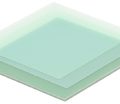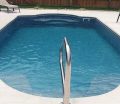
Wet sanding fiberglass tub is an essential technique for restoring and maintaining the smooth, glossy finish of fiberglass surfaces. Fiberglass tubs are commonly used for their durability and versatility in bathrooms, but over time, they can accumulate scratches, stains, and wear. Wet sanding fiberglass tub helps to remove these imperfections and smooth the surface, enhancing both its appearance and longevity. This method uses water to reduce friction and prevent the buildup of dust, which can lead to scratches or uneven finishes. By using the right technique and sandpaper grit, you can achieve a flawless surface that is primed for further refinishing or polishing. Proper wet sanding ensures a durable, long-lasting finish, making it an ideal choice for DIY tub restoration.
What Is Wet Sanding Fiberglass Tub?
Wet sanding fiberglass tub is a meticulous process that involves smoothing and refining the surface of a fiberglass tub using water as a lubricant and various grits of sandpaper. This method is ideal for repairing surface imperfections, removing scratches, and preparing the tub for refinishing or painting. By reducing friction, the water prevents the buildup of heat and minimizes damage to the fiberglass surface. Understanding the techniques and benefits of wet sanding fiberglass tub is crucial for achieving professional-level results in your DIY or restoration projects.
Factors to Consider Before Wet Sanding Fiberglass Tub
Surface Condition of the Tub
Before embarking on the process of wet sanding fiberglass tub, assess the surface condition. Look for visible scratches, chips, or areas of discoloration. These imperfections determine the grit of sandpaper needed and the extent of sanding required. Shallow scratches may only need fine-grit sandpaper, while deeper imperfections could demand coarser options initially.
Tools and Materials Required
Wet sanding fiberglass tub requires specific tools such as waterproof sandpaper, sanding blocks, water spray bottles, and polishing compounds. High-quality materials ensure a smoother finish and reduce the likelihood of introducing new damage during the process.
Experience and Skill Level
For those new to wet sanding fiberglass tub, it’s essential to research and practice beforehand. The process demands precision and care, particularly around curves and edges where over-sanding can thin the material. Beginners may start with less visible areas to gain confidence.
Safety Measures
Fiberglass particles released during sanding can be harmful if inhaled or come into contact with the skin. Always wear protective gloves, safety goggles, and a dust mask. Additionally, ensure proper ventilation or work outdoors when wet sanding fiberglass tub to minimize exposure.
Environmental Factors
The environment where you work plays a significant role. Avoid wet sanding fiberglass tub in extremely cold or hot conditions, as temperature fluctuations can affect the curing process and the final finish.
Steps to Wet Sand Fiberglass Tub Effectively
Preparation of the Tub
Begin by cleaning the tub thoroughly to remove soap scum, grease, or debris. Use a mild detergent and a sponge to ensure the surface is free from contaminants that might interfere with the sanding process.
Selecting the Right Sandpaper
Choose sandpaper grits appropriate for the level of repair needed. Start with a coarse grit such as 400 for deeper scratches and gradually move to finer grits like 1000 or 1500 to smooth the surface. Always keep the sandpaper wet to prevent clogging and maintain an even abrasion.
Applying Water Consistently
When wet sanding fiberglass tub, the consistent application of water is critical. Use a spray bottle or a running faucet to keep the surface lubricated. This reduces heat and helps to remove dust particles, creating a cleaner workspace and better results.
Sanding with Controlled Motion
Work in small sections using light, circular motions to avoid over-sanding. Pay attention to curves and edges, ensuring uniformity across the surface. Take breaks to inspect the progress and adjust the sanding technique as needed.
Polishing for a Smooth Finish
After sanding, polish the tub using a buffing pad and a high-quality compound. This step enhances the shine and restores the fiberglass to its original luster, giving it a professional appearance.
Benefits of Wet Sanding Fiberglass Tub
Superior Surface Finish
One of the primary advantages of wet sanding fiberglass tub is the smooth, glossy finish it produces. By gradually refining the surface with finer grits, you can achieve a mirror-like appearance that elevates the overall aesthetic of the tub.
Reduced Risk of Damage
The use of water in the process minimizes heat and friction, preventing accidental burns or scratches on the fiberglass. This makes wet sanding fiberglass tub a safer method compared to dry sanding.
Cost-Effective Restoration
For DIY enthusiasts, wet sanding fiberglass tub offers a cost-effective way to repair and rejuvenate an aging tub. With basic tools and patience, you can save money compared to professional refinishing services.
Extended Lifespan of the Tub
By addressing surface imperfections and applying a protective polish, wet sanding fiberglass tub helps to prolong the life of the tub. This process shields the fiberglass from further wear and tear, ensuring durability.
Customizable Finish
Whether you prefer a matte or high-gloss look, wet sanding fiberglass tub allows for a tailored finish based on your aesthetic preferences. Adjusting the polishing stage can achieve the desired result.
When to Call a Professional for Wet Sanding Fiberglass Tub
If the fiberglass tub has deep cracks, severe discoloration, or structural issues, professional intervention is recommended. Wet sanding fiberglass tub in such conditions might worsen the damage if not done correctly.
Handling oversized or intricately shaped tubs can be challenging for a DIY approach. Professionals have the expertise and tools to manage the complexities of wet sanding fiberglass tub without compromising the finish.
For homeowners seeking a flawless, factory-grade finish, hiring a professional for wet sanding fiberglass tub ensures high-quality outcomes. Their experience minimizes errors and guarantees a long-lasting shine.
Wet sanding fiberglass tub can be time-consuming, especially for beginners. If you lack the time, tools, or confidence, delegating the task to a professional saves effort while delivering reliable results.
Inexperienced DIY attempts at wet sanding fiberglass tub may lead to unintended damage, such as over-sanding or uneven finishes. Professionals are trained to avoid such issues, preserving the integrity of the tub.
Common Mistakes to Avoid While Wet Sanding Fiberglass Tub
Using the Wrong Grit
Starting with a grit that’s too coarse can create unnecessary scratches, while overly fine sandpaper may not address significant imperfections. Proper selection is key to effective wet sanding fiberglass tub.
Insufficient Lubrication
Failing to keep the surface wet during sanding can lead to friction, heat buildup, and potential damage to the fiberglass. Always maintain adequate moisture throughout the process.
Applying Excessive Pressure
Over-sanding or pressing too hard can thin the fiberglass and compromise the tub’s durability. Use light, even pressure to avoid damaging the material during wet sanding fiberglass tub.
Skipping the Polishing Step
Polishing is a critical final step in wet sanding fiberglass tub. Skipping this step leaves the surface dull and susceptible to further wear and tear.
Ignoring Safety Precautions
Neglecting protective gear and ventilation can pose health risks when wet sanding fiberglass tub. Always prioritize safety to ensure a smooth and secure process.
By following these guidelines and understanding when to seek professional assistance, you can master the art of wet sanding fiberglass tub and enjoy a beautifully restored fixture. Whether tackling a small DIY project or relying on experts, this versatile technique promises outstanding results for any fiberglass tub restoration.
Choosing The Right Fiberglass Rods And Plastic Tubes
Enhancing Your Bathroom with Wet Sanding Fiberglass Tub
Wet sanding fiberglass tub is a vital method for restoring the visual appeal and durability of fiberglass tubs. It involves using water to lubricate the surface and progressively finer grits of sandpaper to smooth out imperfections, remove stains, and prepare the tub for a polished finish. This method not only improves aesthetics but also extends the lifespan of the tub. Whether approached as a DIY project or handled by professionals, wet sanding fiberglass tub is a transformative process that revitalizes even the most worn fixtures.
Fiberglass tubs are prized for their lightweight design and durability, but they are not immune to the effects of daily wear and tear. Scratches, discoloration, and surface dullness can develop over time, detracting from the tub’s appearance. Wet sanding fiberglass tub offers a cost-effective alternative to replacing the tub entirely. By carefully smoothing and polishing the surface, you can restore its original luster and maintain its functionality for years to come.
Step-by-Step Guide to Wet Sanding Fiberglass Tub
Preparing the Tub for Wet Sanding
Start by thoroughly cleaning the tub with a mild detergent to remove grease, soap scum, and debris. A clean surface ensures that the sandpaper works effectively without embedding dirt into the fiberglass. Use painter’s tape to protect surrounding areas such as walls and fixtures, creating a neat and controlled workspace.
Starting with Coarse Sandpaper
For tubs with deep scratches or significant imperfections, begin with a coarse grit such as 400. Wet the sandpaper and the tub surface, then work in light, circular motions. This step focuses on leveling out the most damaged areas, forming a foundation for subsequent sanding stages.
Progressing to Finer Grits
Gradually transition to finer grits, moving from 800 to 1500 or 2000. Each stage further smooths the surface, reducing the visibility of scratches left by the previous grit. Keep the surface wet at all times to minimize friction and heat buildup, which could damage the fiberglass.
Final Polishing Stage
After sanding, apply a fiberglass polishing compound using a soft buffing pad. This step enhances the tub’s shine and seals the surface, making it resistant to future stains and scratches. Polishing is essential for achieving a professional-grade finish during wet sanding fiberglass tub.
Allowing for Proper Drying
Between sanding stages and after polishing, allow the tub to dry completely. This helps reveal areas that may need additional attention and ensures a streak-free finish.
Benefits of Wet Sanding Fiberglass Tub
- Improved Appearance
Wet sanding fiberglass tub restores the surface to its original smooth and shiny state, dramatically improving the overall look of the bathroom. - Increased Durability
By addressing surface imperfections, wet sanding helps protect the tub against further wear, extending its lifespan. - Affordable Maintenance
Wet sanding fiberglass tub is a cost-effective alternative to replacing or professionally refinishing a tub, especially for minor repairs. - Customizable Finish
The process allows you to achieve either a matte or high-gloss finish, depending on personal preferences and bathroom aesthetics. - Eco-Friendly Restoration
Wet sanding uses minimal materials and avoids harsh chemicals, making it an environmentally friendly choice for tub restoration.
Common Mistakes to Avoid During Wet Sanding Fiberglass Tub
Using Incorrect Grit Progression
Skipping grits or starting with a grit that’s too coarse can result in uneven surfaces or additional damage. Follow a gradual progression for the best results.
Applying Excessive Pressure
Pressing too hard during wet sanding fiberglass tub can thin the fiberglass, leading to weak spots. Use light, even pressure to ensure safe and effective sanding.
Skipping Lubrication
Neglecting to keep the surface wet can cause heat buildup and create new scratches. Always maintain consistent moisture with a spray bottle or running water.
Rushing Through Stages
Each step in wet sanding fiberglass tub builds upon the last. Skipping stages or rushing through the process compromises the quality of the finish.
Neglecting Safety Measures
Fiberglass particles can be harmful if inhaled or touched. Wear gloves, goggles, and a dust mask to protect yourself throughout the process.
Preventing Zippered Fiberglass Body Tube Damage in Rocketry
The Importance of Wet Sanding Fiberglass Tub
Wet sanding fiberglass tub is more than a cosmetic fix—it’s a way to preserve the tub’s structural integrity. Fiberglass tubs are exposed to constant moisture, cleaning agents, and daily use, all of which can degrade their surface over time. Wet sanding effectively reverses these effects, restoring the tub to its former glory.
The process also provides a sustainable solution for homeowners looking to refresh their bathroom without replacing major fixtures. By investing time in wet sanding fiberglass tub, you can achieve a finish that rivals professional refinishing services at a fraction of the cost. The method is suitable for addressing minor scratches, discoloration, and even preparing the tub for new paint or coatings.
Tubs with significant damage, such as cracks or large chips, may require professional intervention. Attempting to repair these issues without the necessary expertise could worsen the damage.
For tubs with complex shapes or detailed patterns, professionals have the tools and experience to achieve an even and polished finish.
If you want a showroom-grade result, hiring a professional ensures a flawless surface and long-lasting durability.
Wet sanding fiberglass tub can be time-consuming and requires specific tools. Professionals can complete the task efficiently while ensuring top-notch results.
Inexperienced DIYers may inadvertently damage the tub. Professional assistance reduces this risk and guarantees a polished, professional outcome.
Wet sanding fiberglass tub is an invaluable technique for maintaining and restoring fiberglass tubs. Whether approached as a DIY project or handled by professionals, this method offers unparalleled benefits for enhancing the appearance, durability, and value of your bathroom centerpiece. By following proper steps, avoiding common mistakes, and recognizing when to seek expert help, you can achieve a beautifully restored tub that stands the test of time.
Why Fiberglass Shaft Tubes Are Ideal for Marine Use
FAQs about Wet Sanding Fiberglass Tub
Yes, you can sand a fiberglass bathtub, but it requires care and the right techniques to ensure a smooth and even finish. Fiberglass bathtubs are often made with a gel coat surface that can be damaged if not sanded properly. If the bathtub has scratches, chips, or an uneven surface, sanding can help restore its appearance. It’s important to start with a coarse grit sandpaper to remove any imperfections, followed by finer grits to smooth out the surface. Always make sure to sand gently and in a circular motion to avoid gouging or damaging the surface. Additionally, if the bathtub is coated with a glossy finish, sanding can reduce the shine, so you might need to polish it afterward for a smooth, shiny look. Be sure to clean the area thoroughly before and after sanding to avoid debris affecting the finish.
Yes, wet sanding can be done on a bathtub, and it is actually a preferred method for sanding fiberglass surfaces. Wet sanding helps to reduce dust and makes the sanding process smoother. When wet sanding a bathtub, water helps to lubricate the surface, preventing the sandpaper from clogging and ensuring an even application. It’s particularly useful for finer grit sandpapers, which can easily become clogged with residue. Wet sanding also minimizes the risk of creating deep scratches or marks on the bathtub surface. To wet sand a bathtub, simply soak the sandpaper in water, then gently sand the surface in circular motions. Be sure to rinse the bathtub regularly to remove excess water and debris. Afterward, dry the area thoroughly before applying any finishing products, such as polish or sealant.
When wet sanding fiberglass, it’s important to choose the right grit sandpaper to achieve a smooth and even finish without damaging the surface. For initial sanding, start with a coarser grit, such as 400 or 600, to remove imperfections or old finish. This will help you smooth out any rough spots or deep scratches. Once the surface is even, gradually move to finer grits, like 800, 1000, or even 1500, for a smoother finish. The finer the grit, the smoother and glossier the finish will be. Always make sure to use wet sanding techniques to avoid excessive buildup of dust and to achieve a cleaner result. Using high-quality wet sandpaper designed for fiberglass is also crucial to ensure a longer-lasting and effective sanding process.

As the editor of GangLong Fiberglass, I have years of experience and in-depth research, focusing on cable tray products, fiberglass solutions, and grille systems. I incorporate years of industry insights and practical experience into every content, committed to promoting the progress of the industry. At GangLong Fiberglass, my commitment is reflected in every product, from innovative cable trays to durable fiberglass solutions and sturdy grille systems. As an authoritative voice in the industry, my goal is to provide valuable information to professionals and businesses and promote forward-looking solutions.


